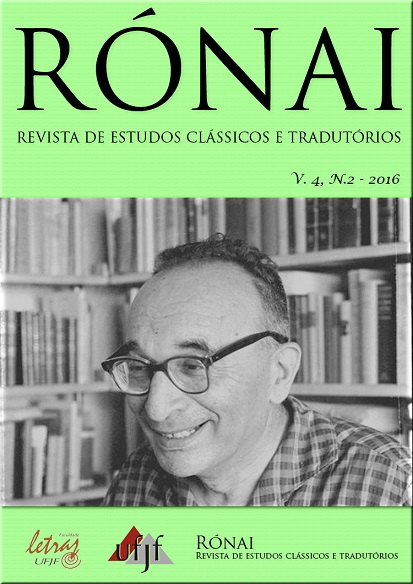Tradução como procedimento intertextual: a recriação de Leminski do Satyricon, de Petrônio
Palabras clave:
Satyricon, Paulo Leminski, tradução criativa, intertextualidadeResumen
O presente trabalho destaca algumas características da tradução do Satyricon, de Petrônio, realizada pelo poeta Paulo Leminski. Nossa análise se dará por meio da interlocução entre a teoria intertextual e as próprias concepções instauradas pelo poeta sobre tradução. Destacaremos as similaridades entre as teorias mencionadas, as quais refletem o fazer tradutório, neste caso, o texto latino de partida e sua reinvenção em língua portuguesa, por meio da tradução no texto de chegada, destacando trechos que revelam a apropriação do texto latino.
Descargas
Citas
AULETE, C. Aulete digital – Dicionário contemporâneo da língua portuguesa. Dicionário Caldas Aulete, Lexikon, 2007. Acessado em 10 de julho de 2016. Disponível em: http://www.auletedigital.com.br.
BAILLY. A. Dictionnaire Grec-Français. Paris: Hachette, 2000.
BARCHIESI, A.; CONTE, G. B. Imitazione e Arte Allusiva. Modi e Funzionedell’Itertestualità. In: CAVALLO, G. et alii (direttori). Lo Spazio Letterariodi Roma Antica. Roma: Salerno, 1989.
CAMPOS, A. Verso, reverso, controverso. São Paulo: Perspectiva, 1978.
CAMPOS, H. A arte no horizonte do provável. São Paulo: Perspectiva, 1977.
_____. “Uma Leminskíada Barrocodélica”. Metalinguagem e outras metas. São Paulo: Perspectiva, 2010, p. 213-220.
CARMIGNANI, M. El Satyricon de Petronio: tradición literária e intertextualidade. Córdoba: Universidad Nacional de Córdoba, 2011.
CONTE, G. B. Memoria dei poeti e sistema litterario: Cattulo, Virgilio, Ovidio, Lucano. Palermo: Sellerio, 2012.
FOWLER, D. On the shoulders of giants: intertextuality and classical studies, in: Roman constructions. Readings in postmodern Latin. Oxford: Oxford University, 2000.
GLARE, p. G. W. Oxford Latin Dictionary. London: Oxford University Press, 1968.
LEMINSKI, p. Distraídos venceremos. São Paulo: Brasiliense, 1993
_____. Ensaios e Anseios Crípticos. Campinas: Editora Unicamp, 2011
_____. Cenas de vanguarda explícita. Folha de São Paulo, São Paulo, 04 dez. 1985. Ilustrada. p. 44.
_____. O crepúsculo dos críticos. Folha de São Paulo, São Paulo, 27 abr. 1985A. Ilustrada. p. 36.
_____. Latim com gosto de vinho tinto. In: PETRÔNIO. Satyricon. Trad. de Paulo Leminski. São Paulo: Brasiliense, 1985.
_____; BONVICINO, R. Envie meu dicionário: cartas e alguma crítica. São Paulo: Ed. 34, 1999.
LIDELL, H. G. SCOTT, R. A Greek-English lexicon. Oxford: Clarendon Press, 1996.
MELO, T. M. de. Tradução da Tradição: anotações sobre os motores da poesia de Paulo Leminski. Kamiquase, 1998. Disponível em: http://www.elsonfroes.com.br/kamiquase/ ensaio2.htm. Acesso em: 5 ago 2016.
MORENO, S. Ecos e Reflexos: A construção do Cânone de Augusto e Haroldo de Campos a partir de suas concepções de tradução. Campinas: Tese (Doutorado em Linguística Aplicada). Estudos da Linguagem da Universidade Estadual de Campinas, 2001.
PÉTRONE. Le satiricon. Trad. de Maurice Rat. Paris: Garnier, 1948.
_____. Le Satiricon. Ed. A. Ernout. Paris: Les Belles Lettres, 1974.
PETRÔNIO. Satyricon. Trad. de Paulo Leminski. São Paulo: Brasiliense, 1985.
_____. Satyricon. Trad. de Sandra M. G. Braga Bianchet. Belo Horizonte: Crisálida, 2004.
_____. Satíricon. Tradução e posfácio: Cláudio Aquati. São Paulo: Cosac Naify, 2008.
SANTANA, I. J. Paulo Leminski: Intersemiose e Carnavalização na tradução. São Paulo: (Dissertação de Mestrado em Estudos da Tradução). Faculdade de Filosofia, Letras e Ciências Humanas, Universidade de São Paulo, 2002.
SARAIVA, F. R. S. Novíssimo dicionário latino-português. Belo Horizonte; Rio de Janeiro: Livraria Garnier, 2006.
VACONCELLOS, p. S. de. Efeitos intertextuais na Eneida de Virgílio. São Paulo: Humanitas, 2001.
Descargas
Publicado
Cómo citar
Número
Sección
Licencia
Derechos de autor 2017 Lívia Mendes Pereira

Esta obra está bajo una licencia internacional Creative Commons Atribución 4.0.
Derechos de autor
Los autores que publican en esta revista aceptan los siguientes términos:
1. Los autores y las autoras conservan los derechos de autor y le otorgan a la revista el derecho a la primera publicación, que está bajo la licencia Creative Commons Attribution License 4.0 Internacional.
2. Los autores y las autoras pueden publicar y compartir el trabajo con reconocimiento de la publicación inicial en esta revista.
3. Los autores y las autoras de las obras aprobadas autorizan a la revista a asignar el contenido de sus obras, después de la publicación, para su reproducción en indexadores de contenido, bibliotecas virtuales y similares.
Para obtener más información sobre Creative Commons Attribution License 4.0 Internacional, acceda a: https://creativecommons.org/licenses/by/4.0/deed.es
Exención editorial
El contenido de los artículos publicados es responsabilidad única y exclusiva de sus autores, y no representa la posición oficial de Rónai - Revista de Estudos Clássicos e Tradutórios o de la Faculdade de Letras de la Universidad Federal de Juiz de Fora o instituciones asociadas.



